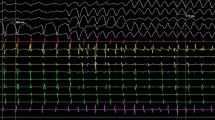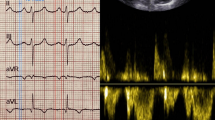Abstract
Introduction
Supraventricular tachyarrhythmias (SVTA) are an accepted cause of cardiac arrest in patients with Wolff–Parkinson–White syndrome (WPW) and hypertrophic cardiomyopathy but their participation in other conditions is less well understood. The purpose of the study was to examine the role of SVTA in sudden cardiac arrest (SCA) by comprehensive evaluation of patients successfully resuscitated from SCA.
Methods
A total of 169 survivors of SCA in the absence of acute myocardial infarction underwent systematic evaluation that included echocardiography, Holter monitoring, coronary angiography and electrophysiological study (EPS) with additional testing in selected cases using provocative drug testing with isoproterenol, ajmaline or ergonovine.
Results
SVTA was found as the only possible cause or as the cause facilitating SCA in 29 patients: (1) 3 had a WPW syndrome related to accessory pathway with short refractory period; (2) for 12 patients, SVTA was the cause of cardiovascular collapse; heart disease (HD) was present in 11 cases, but disappeared in two of four with dilated cardiomyopathy after the restoration of sinus rhythm; (3) in 14 patients, SVTA degenerated either in a VF or ventricular tachycardia (VT); HD was present in 12 cases, but disappeared in one; two had no HD and recurrent similar arrhythmia was documented by cardiac defibrillator in one of them. SVTA induced coronary ischemia was the main cause of SCA.
Conclusion
Rapid SVTA was a cause of SCA, either by cardiovascular collapse or by the degeneration in VT or VF. The complication generally occurred in patients with advanced HD or with rapid SVTA-induced cardiomyopathy and rarely in patients without HD. The incidence of SVTA as the only cause or the facilitating cause of SCAs is probably underestimated, because it is difficult to prove.
Similar content being viewed by others
References
AVID investigators. (1997). The antiarrhythmics versus implantable defibrillators (AVID) investigators: A comparison of antiarrhythmic drugs therapy with implantable defibrillators in patients resuscitated from near fatal ventricular arrhythmias. New England Journal of Medicine, 337, 1576–1583.
Connolly, S. J., Gent, M., Roberts, R. S., Dorian, P., Roy, D., Sheldon, R. S., et al. (2000). Canadian Implantable Defibrillator Study (CIDS): A randomized trial of the implantable cardioverter defibrillator against amiodarone. Circulation, 101, 1297–1302.
Kuck, K. H., Cappato, R., Siebels, J., & Rüppel, R. for the CASH investigators. (2000). Randomized comparison of antiarrhythmic drug therapy drug therapy with implantable defibrillators in patients resuscitated from cardiac arrest: The Cardiac Arrest Study Hamburg (CASH). Circulation, 102, 748–754.
Mikalic, G., Bishop, R. L., & Singh, J. B. (1982). Sudden death recorded during Holter monitoring. Circulation, 66, 218–225.
Leclercq, J. F., Coumel, P., Maisonblanche, P., Cauchemez, B., Zimmermann, M., Chouty, F., et al. (1986). Mise en évidence des mécanismes déterminants de la mort subite. Archives des Maladies du Coeur, 79, 1024–1033.
Kempf, F. C., & Josephson, M. E. (1984). Cardiac arrest on ambulatory electrocardiogram. American Journal of Cardiology, 53, 1577–1582.
Kereiakes, D. J., Morady, F., Heath, D., Parsons, T., & Scheinman, M. M. (1984). Sudden death during ambulatory electrocardiographic monitoring: importance of morphologic confirmation to establish cause of death. American Journal of Cardiology, 54, 1603–1604.
Zipes, D. P., & Wellens, H. J. J. (1998). Sudden cardiac death. Circulation, 98, 2234–2251.
Hinkle, L. E., & Thaler, J. (1982). Clinical classification of cardiac deaths. Circulation, 65, 457–464.
Simon, S. R., Powell, L. H., Bartzokis, J. C., & Hoch, D. H. (1995). A new system for classification of cardiac death as arrhythmic ischemic or due to myocardial pump failure. American Journal of Cardiology, 76, 896–898.
Pratt, C. M., Greenway, P. S., Schoenfeld, M. H., Hibben, M. L., & Reiffel, J. A. Z. (1996). Exploration of the precision of classifying sudden cardiac death. Implications for the interpretation of clinical trial. Circulation, 93, 519–524.
Brembilla-Perrot, B., Miljoen, H., Houriez, P., Beurrier, D., Nippert, M., Vançon, A. C., et al. (2003). Causes and prognosis of cardiac arrest in a population admitted to a general hospital: A diagnostic and therapeutic problem. Resuscitation, 58, 319–327.
Laham, J., & Brembilla-Perrot, B. (2003). Syndromes de préexcitation ventriculaire. Monographies de cardiologie, Ed Masson.
Maron, B., McKenna, W. J., Danielson, G. K., Kappenberger, L. J., Kuhn, H. J., Seidman, C. E., et al. (2003). American College of Cardiology/European Society of Cardiology clinical expert consensus on hypertrophy cardiomyopathy. A report of the American College of Cardiology Fundation Task force on clinical expert consensus documents and the European Society of Cardiology Committee for practice guidelines. European Heart Journal, 24, 1965–1991.
Wang, Y. S., Scheinman, M. M., Chien, W. W., Cohen, T. J., Lesh, M. D., & Griffin, J. C. (1991). Patients with supraventricular tachycardia presenting with aborted sudden death.: incidence, mechanism and long-term follow-up. Journal of the American College of Cardiology, 18, 1711–1719.
The Atrial fibrillation Follow-up investigation of Rhythm management (AFFIRM) Investigators. (2002). A comparison of rate control and rhythm in patients with atrial fibrillation. New England Journal of Medicine, 347, 1825–1833.
Brembilla-Perrot, B., Suty-Selton, C., Beurrier, D., Houriez, P., Nippert, M., Terrier de la Chaise, A., et al. (2004). Differences in mechanisms and outcomes of syncope in patients with coronary disease or idiopathic left ventricular dysfunction as assessed by electrophysiologic testing. Journal of the American College of Cardiology, 44, 594–601.
Torner Montoya, P., Brugada, P., Smeets, J., Talajic, M., Della-Bella, A., Lezaun, R., et al. (1991). Ventricular fibrillation in the Wolff–Parkinson–White syndrome. European Heart Journal, 12, 144–150.
Timmermans, C., Smeets, J. L. R. M., Rodriguez, L. M., Vrouchos, G., Van Den Dool, A., & Wellens, H. J. J. (1995). Aborded sudden death in the Wolff–Parkinson–White syndrome. American Journal of Cardiology, 76, 492–494.
Paponne, C., Manguso, F., Santinelli, V., Vicedomini, G., Sala, S., Paglino, G., et al. (2004). Radiofrequency ablation in children with asymptomatic Wolff–Parkinson–White syndrome. New England Journal of Medicine, 351, 1197–1205.
The Atrial Fibrillation Follow-up Investigation of Rhythm Management (AFFIRM) Investigators. (2002). A comparison of rate control and rhythm control in patients with atrial fibrillation. New England Journal of Medicine, 347, 1834–1840.
Dries, D. L., Exner, D. V., Gersh, B. J., Domanski, M. J., Waclowin, M. A., & Stevenson, L. W. (1998). Atrial fibrillation is associated with an increased risk for mortality and heart failure progression in patients with asymptomatic and symptomatic left ventricular systolic dysfunction: A retrospective analysis of the SOLVD. Journal of the American College of Cardiology, 32, 695–703.
Nerheim, P., Birger-Botkin, S., Piracha, L., & Olshansky, B. (2004). Heart failure and sudden death in patients with tachycardia-induced cardiomyopathy and recurrent tachycardia. Circulation, 110, 247–252.
Hsu, L. F., Jaïs, P., Sanders, Garrigue, S., Hocini, M., Sacher, F., et al. (2004). Catheter ablation for atrial fibrillation in congestive heart failure. New England Journal of Medicine, 351, 2373–2383.
Stein, K. M., Euler, D. E., Mehra, R., Deidl, K., Slotwiner, D. J., Mittal, S., et al. (2002). Do atrial tachyarrhythmias beget ventricular tachyarrhythmias in defibrillator recipients? Journal of the American College of Cardiology, 40, 335–340.
Deneke, T., Lawo, T., Gerritse, B., Lemke, B., for the European GEM DR investigators. (2004). Mortality of patients with implanted cardioverter/defibrillators in relation to episodes of atrial fibrillation. Europace, 6, 151–158.
Motté, G., Sebag, C., Belhassen, B., Vaysse, J., & Welti, J. J. (1979). Les bitachycardies. Archibes des Maladies du Coeur, 73, 336–348.
Zipes, D. P., Foster, P. R., Troup, P. J., & Pedersen, D. H. (1979). Atrial induction of ventricular tachycardia: Reentry versus triggered automaticity. American Journal of Cardiology, 44, 1–8.
Anderson, J. L. (1991). Supraventricular tachyarrhythmias: Not always so benign. Journal of the American College of Cardiology, 18, 1720–1721.
Grimm, W., Hoffmann, J., Müller, H. H., & Maish, B. (2002). Implantable defibrillator event rates in patients with idiopathic dilated cardiomyopathy, nonsustained ventricular tachycardia on Holter and a left ventricular ejection fraction below 30%. Journal of the American College of Cardiology, 39, 780–787.
Moss, A. J., Zareba, W., Hall, J., Klein, H., Wilber, D. J., Cannom, D. S., et al., for the Multicenter Automatic Defibrillator Implantation. Trial II Investigators. (2002). Prophylactic implantation of a defibrillator in patients with myocardial infarction and reduced ejection fraction. New England Journal of Medicine, 346, 877–883.
Wyse, D. G., Friedman, P. L., Brodsky, M. A., Beckman, K. J., Carlson, M. D., Curtis, A. B., et al. for the AVID investigators. (2001). Life-threatening ventricular arrhythmias due to transient or correctable causes: high risk for death in follow-up. Journal of the American College of Cardiology, 38, 1718–1724.
Brembilla-Perrot, B., Marçon, O., Blangy, H., Terrier de la Chaise, A., Louis, P., Sadoul, N., et al. (2006). Incidence des tachycardies et tachyarythmies supraventriculaires dans les morts subites récupérées. Archives des Maladies du Coeur, 99, 33–38.
Author information
Authors and Affiliations
Corresponding author
Rights and permissions
About this article
Cite this article
Brembilla-Perrot, B., Marçon, O., Chometon, F. et al. Supraventricular tachyarrhythmia as a cause of sudden cardiac arrest. J Interv Card Electrophysiol 16, 97–104 (2006). https://doi.org/10.1007/s10840-006-9042-4
Received:
Accepted:
Published:
Issue Date:
DOI: https://doi.org/10.1007/s10840-006-9042-4




